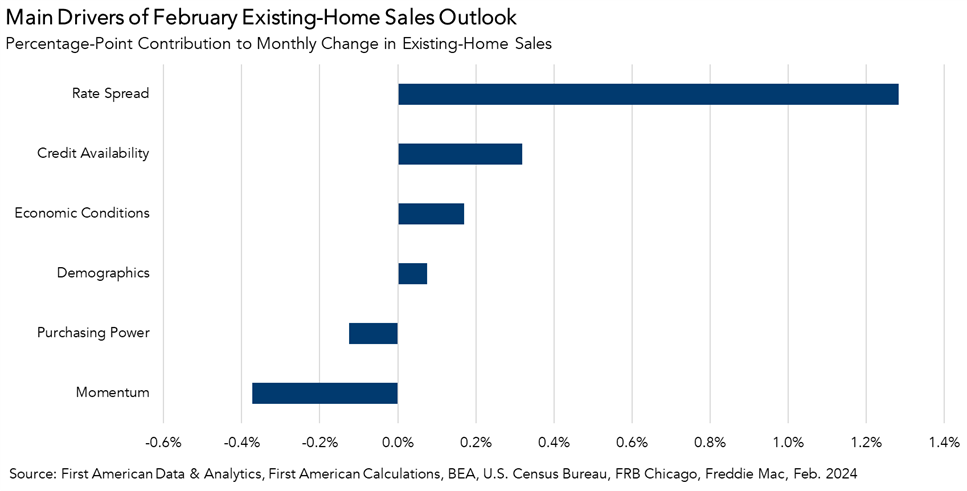New Existing-Home Sales Outlook Report Projects Uptick in Sales, Despite Rising Mortgage Rates
By Mark Fleming
On average, nearly 40 percent of all existing-home sales in a year occur during the spring home-buying season between April and June. The warming weather and the end of the academic school year make for a more optimal time to move and fuel the seasonal increase in housing market activity. In the spring of 2023, home sales were lackluster. Housing inventory picked up compared with 2022, but remained near historic lows as mortgage rates hovered near a two-decade high, over a full percentage point higher than the prior spring. As the 2024 spring home-buying season approaches, homeowners, prospective buyers and the broader housing industry is wondering – will this be the year that existing-home sales activity accelerates?
Our new Existing-Home Sales Outlook Report ‘nowcasts’ existing-home sales based on the historical relationship between sales demographic trends, house-buying power, and the prevailing financial and economic conditions. Based on our nowcast, we expect February existing-home sales to rise 1.4 percent to a seasonally adjusted annualized rate of 4.05 million, an optimistic sign for the spring home-buying season.
The Main Drivers of the Home Sales Outlook
Increasing household formation and credit availability, as well as strong economic conditions, boosted our nowcast for existing-home sales. Combined, these macro-trends contributed 0.6 percentage points to February’s projected increase of 1.4 percent. The average 30-year, fixed mortgage rate increased in February, reducing home-buying power, which dragged down our nowcast for existing-home sales by 0.1 percentage points.
The narrowing mortgage rate spread was the largest driver of the projected increase in our February Existing-Home Sales Outlook. Approximately 90 percent of homeowners are financially disincentivized from selling their home in today’s housing market because it would cost more today to borrow the same amount of money they owe on their current mortgage. In February, a narrowing of the spread between the average 30-year, fixed mortgage rate and the effective rate of interest on mortgage debt outstanding fueled a 1.3 percentage point increase in the projected monthly change in existing-home sales. However, the majority of existing homeowners remain rate-locked in. You can’t buy what’s not for sale and, even with a narrower mortgage rate spread, existing homeowners aren’t selling.
Mortgage rates are expected to recede eventually as the Federal Reserve cuts interest rates, and that should result in downward pressure on mortgage rates. However, that is unlikely to occur until the spring home-buying season is well under way. Punxsutawney Phil predicted that spring would come early this year, but it’s looking more and more like a big spring home-buying boost to sales from lower mortgage rates may have to wait.
First American Economist Ksenia Potapov contributed to this article.
Mark Fleming is chief economist at First American.
February 2024 Existing-Home Sales Outlook
For the month of February, First American updated its Existing-Home Sales Outlook to show that:
- Existing-home sales are expected to increase to a 4.05 million seasonally adjusted annualized rate (SAAR), a 1.4 percent increase from January’s actual pace of sales.
- Our projected February seasonally adjusted annualized rate of 4.05 million existing home sales is down 11 percent compared with the actual pace of sales a year ago, a loss of 476,000 (SAAR) sales.
- The largest contributors to the projected monthly change are a decline in the mortgage rate spread between the current and effective rates (+1.3 percentage points), greater credit availability (+0.3 percentage points), and a boost in economic conditions (+0.2 percentage points).
Methodology
Our Existing-Home Sales Outlook Report ‘nowcasts’ existing-home sales, which include single-family homes, townhomes, condominiums, and co-ops on a seasonally adjusted annualized rate based on the historical relationship between existing-home sales, U.S. demographic trends, house-buying power, and the prevailing financial and economic conditions, as well as momentum, a weight assigned to past values. Please note that the Existing-Home Sales Outlook Report is based on assumptions about demographic, economic and financial conditions. Actual values may differ from those projected. Recent existing-home sales estimates are subject to revision to reflect the most up-to-date information available on the economy, housing market and financial conditions.





